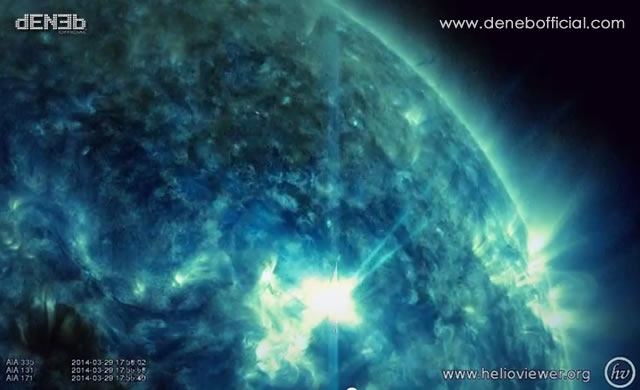
La nostra stella, il sole, è circondata da una grande atmosfera di particelle solari, attraverso cui pullulano i campi magnetici, eruttano i brillamenti solari e dove gigantesche colonne di materiale hanno origine, cadendo e spintonandosi a vicenda tutto intorno. Usando il Solar Terrestrial Relations Observatory della NASA, gli scienziati hanno scoperto che questa atmosfera, chiamata corona, è ancora più grande di quanto si pensasse, e si estende su circa 5 milioni di miglia sopra la superficie del sole, l’equivalente di 12 raggi solari.
Questa informazione comporta implicazioni per la prossima missione della NASA Solar Probe Plus il cui lancio è previsto nel 2018 e che andrà più vicino al Sole rispetto a qualsiasi tecnologia umana abbia mai fatto prima d’ora. Queste osservazioni delle sonde STEREO forniscono le prime misurazioni dirette del limite interno dell’eliosfera, la bolla gigante scarsamente riempita di particelle solari che circonda il sole e tutti i pianeti. In combinazione con le misure fornite da Voyager 1 del confine esterno della eliosfera, ora abbiamo definito la portata di questa intera bolla locale. “Abbiamo rintracciato le onde del suono, come attraverso la corona esterna e usato queste per mappare l’atmosfera”, ha detto Craig DeForest del Southwest Research Institute di Boulder, in Colorado. “Non possiamo sentire i suoni direttamente attraverso il vuoto dello spazio, ma con un’attenta analisi possiamo vederli ondeggiare attraverso la corona.” I risultati sono stati pubblicati su “The Astrophysical Journal” lo scorso 12 maggio 2014. I ricercatori hanno studiato le onde note come onde magnetosoniche, che sono un ibrido di onde sonore e onde magnetiche chiamate onde di Alfvén. A differenza delle onde sonore sulla Terra che oscillano diverse centinaia di volte al secondo, queste onde oscillano circa una volta ogni quattro ore e sono circa 10 volte la lunghezza della Terra.
Surrounding the sun is a vast atmosphere of solar particles, through which magnetic fields swarm, solar flares erupt, and gigantic columns of material rise, fall and jostle each other around. Now, using NASA’s Solar Terrestrial Relations Observatory, scientists have found that this atmosphere, called the corona, is even larger than thought, extending out some 5 million miles above the sun’s surface — the equivalent of 12 solar radii.
This information has implications for NASA’s upcoming Solar Probe Plus mission, due to launch in 2018 and go closer to the sun than any man-made technology ever has before. These STEREO observations provide the first direct measurements of the inner boundary of the heliosphere — the giant bubble sparsely filled with solar particles that surrounds the sun and all the planets. Combined with measurements from Voyager 1 of the outer boundary of the heliosphere, we have now defined the extent of this entire local bubble. “We’ve tracked sound-like waves through the outer corona and used these to map the atmosphere,” said Craig DeForest of the Southwest Research Institute in Boulder, Colorado. “We can’t hear the sounds directly through the vacuum of space, but with careful analysis we can see them rippling through the corona.” The results were published in The Astrophysical Journal on May 12, 2014. The researchers studied waves known as magnetosonic waves, and they are a hybrid of sound waves and magnetic waves called Alfven waves. Unlike sound waves on Earth, which oscillate several hundred times per second, these waves oscillate about once every four hours — and are about 10 times the length of Earth.
Source/Continue reading → NASA.gov





















